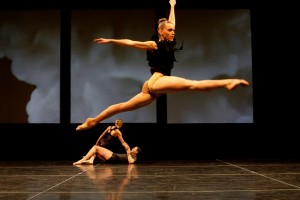By Rachel Straus
Stephen Petronio likes underwear. His steely and mellifluous skeins of movement—via the bare legs and buttocks of talented dancers—can be transporting. In Petronio’s New York premiere of “Underland,” the first ten minutes was beautiful. But as time progressed on April 10 at the Joyce Theater, “Underland” became an aerobic workout for the eyes. The dancers never stopped moving. Then there was the matter of the work’s subject.
Created on and for the Sydney Dance Company in 2003, “Underland” initially seemed to be about Australia. The evening-length piece incorporated music by the Australian rocker Nick Cave. It projected video, created by fellow Down Under filmmaker Mike Daly. Daly and Cave’s work explored human doom and gloom. But Petronio’s channeling of the fashion world, particularly its blank stares of runway models, felt at odds with the collaborators’ ideas. As his 12 performers bounded through space, beating their legs together and then splitting them open with utter ease, they looked detached. Their faces bore no relationship to the ecstasy of their movements—or to Armaggedon.
Photo: Julie Lemberger
Mired in multiple ideas, “Underland”‘s elements never quite coalesced. Petronio’s kinesthetically driving choreography made the dancers appear invincible. Daly’s video—with its projected images of atomic mushroom clouds, raging fires, and towns flattened by a tsunami—featured environmental havoc. Cave’s lyrics delivered a vague malaise. Yet in the section named after Cave’s “Weeping Song,” the dance and music elements cohered. The cast (costumed in Tara Subkoff’s military-style fatigues) marched in geometric patterns. Cave’s song, a march and a lament, supported the choreography. When one and then two performers broke out of their soldier-like lines, their gesturally-driven solos and duets seemed to speak of loss of life.
The audience, however, didn’t react to “Weeping Song” with the same enthusiasm as the section titled “Ship Song.” Named after Cave’s 2001 hit, “Ship” featured four performers who swayed at the lip of the stage, as though on a crowded steamer. Gino Grenek appeared in underwear and a leather trench coat. Amanda Wells and Shila Tirabassi wore late 19th century slip dresses. Their swaying evolved into a languid-style orgy, where they grabbed each other’s breasts, kissed and swooned. But being on a boat (perhaps bound for an Australian penal colony) seemed beside the point. It was the underwear, and what lies beneath it, that made this part of “Underland” clearly understandable.
